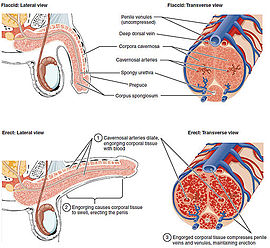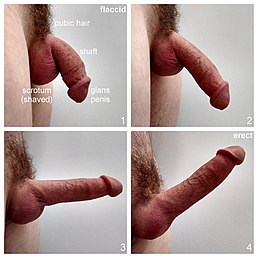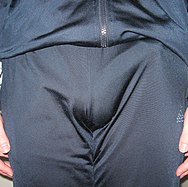Erection
| Erection | |
|---|---|
 Erection of an uncircumcised male human | |
 Three columns of erectile tissue make up most of the volume of the penis. | |
| Identifiers | |
| MeSH | D010410 |
| TE | E1.0.0.0.0.0.8 |
| Anatomical terminology | |
| Erection blood vessels | |
|---|---|
| Identifiers | |
| MeSH | D010410 |
| TE | E1.0.0.0.0.0.8 |
| Anatomical terminology | |
An erection (clinically: penile erection or penile tumescence) is a physiological phenomenon in which the penis becomes firm, engorged, and enlarged. Penile erection is the result of a complex interaction of psychological, neural, vascular, and endocrine factors, and is often associated with sexual arousal, sexual attraction or libido, although erections can also be spontaneous. The shape, angle, and direction of an erection vary considerably between humans.
Physiologically, an erection is required for a male to effect penetration or
As an autonomic nervous system response, an erection may result from a variety of stimuli, including
The state of a penis which is partly, but not fully, erect is sometimes known as semi-erection (clinically: partial tumescence); a penis which is not erect is typically referred to as being flaccid, or soft.
Physiology
An erection is necessary for natural insemination as well as for the harvesting of sperm for artificial insemination, and is common for children and infants. After reaching puberty, erections occur much more frequently.[1][2] An erection occurs when two tubular structures, called the
In some cases, the scrotum becomes tightened during an erection, and in most uncircumcised males, the foreskin automatically and gradually retracts throughout the various stages of erection, exposing the glans, though some individuals have to manually retract their foreskin.
Autonomic control
In the presence of mechanical stimulation, erection is initiated by the
After ejaculation or cessation of stimulation, erection usually subsides, but the time taken may vary depending on the length and thickness of the penis.[10]
Voluntary and involuntary control
The cerebral cortex can initiate erection in the absence of direct mechanical stimulation (in response to visual, auditory, olfactory, imagined, or tactile stimuli) acting through erectile centers in the lumbar and sacral regions of the spinal cord.[11] The cortex may suppress erection, even in the presence of mechanical stimulation, as may other psychological, emotional, and environmental factors.[12]
Nocturnal erection
The penis may become erect during sleep or be erect on waking up. Such an erection is medically known as nocturnal penile tumescence (informally: morning wood or morning glory).[13][14][15][16]
Socio-sexual aspects
Social
Though an erection can have many causes, the more common indicator of sexual arousal has a prevalent view over society and its portrayal in public is considered taboo in many societies. This taboo is lesser than that surrounding public sex but higher than that surrounding nudity. Erectile dysfunction is considered a flaw that associates shame at the individual and his partner.
The
Spontaneous or random erections
Spontaneous erections, also known as involuntary, random or unwanted erections, are commonplace and a normal part of male physiology. Socially, such erections can be embarrassing if they happen in public or when undesired.[1] Such erections can occur at any time of day, and if clothed may cause a bulge which (if required) can be disguised or hidden by wearing close-fitting underwear, a long shirt, or baggier clothes.[17]
Size
The length of the flaccid penis is not indicative of the length of the penis when it becomes erect, with some smaller flaccid penises growing much longer, and some larger flaccid penises growing comparatively less.[18] Generally, the size of an erect penis is fixed throughout post-pubescent life. Its size may be increased by surgery.[19]
Though the size of a penis varies considerably between males, the average length of an erect human penis is 13.12 cm (5.17 inches), while the average circumference of an erect human penis is 11.66 cm (4.59 inches).[20]
Direction
Although many erect penises point upwards, it is common and normal for the erect penis to point nearly vertically upwards or horizontally straight forward or even nearly vertically downwards, all depending on the tension of the suspensory ligament that holds it in position. An erect penis can also take on a number of different shapes, ranging from a straight tube to a tube with a curvature up or down or to the left or right. An increase in penile curvature can be caused by Peyronie's disease. This may cause physical and psychological effects for the affected individual, which could include erectile dysfunction or pain during an erection. Treatments include oral medication (such as colchicine) or surgery, which is most often performed only as a last resort.

The following table shows how common various erection angles are for a standing male. In the table, zero degrees (0°) is pointing straight up against the abdomen, 90° is horizontal and pointing straight forward, and 180° is pointing straight down to the feet. An upward pointing angle is most common and the average erection angle is 74.3 degrees. The penile curvature was measured same time. 63% men have straight penis. 22.2% men have upwards curvature and 14.8% men have downwards curvature.[21]
| Angle (°) | Percent of population |
|---|---|
| 0–30 | 4.9 |
| 30–60 | 29.6 |
| 60–85 | 30.9 |
| 85–95 | 9.9 |
| 95–120 | 19.8 |
| 120–180 | 4.9 |
Medical conditions
Erectile dysfunction
Erectile dysfunction (also known as ED or "(male) impotence") is a sexual dysfunction characterized by the inability to develop and/or maintain an erection.[22][23] The study of erectile dysfunction within medicine is known as andrology, a sub-field within urology.[24]
Erectile dysfunction may occur due to
Erectile dysfunction, tied closely as it is to cultural notions of potency, success and masculinity, can have devastating psychological consequences including feelings of shame, loss or inadequacy.[27] There is a strong culture of silence and inability to discuss the matter. Around one in ten men experience recurring impotence problems at some point in their lives.[28]
Priapism
Priapism is a painful condition in which the penis does not return to its flaccid state, despite the absence of both physical and psychological stimulation. Priapism lasting over four hours is a medical emergency.
Other animals

At the time of penetration, the
An
Given the small amount of erectile tissue in a
A male fossa's penis reaches to between his forelegs when erect.[33]
When not erect, a
A
Terminology
Clinically, erection is often known as "penile erection", and the state of being erect, and process of erection, are described as "tumescence" or "penile tumescence". The term for the subsiding or cessation of an erection is "detumescence".
Colloquially and in slang, erection is known by many informal terms. Commonly encountered English terms include 'stiffy', 'hard-on', 'boner' and 'woody'.[42] There are several slang words, euphemisms and synonyms for an erection in English and in other languages (see also: The WikiSaurus entry).
See also
- Clitoral erection
- Cock ring
- Death erection
- Human penis
- Issues in social nudity
- Nipple stimulation
- Priapism
- Sexual function
References
- ^ ISBN 978-1-55704-769-4. Retrieved 22 July 2013.
- ^ Goldblatt, Howard (1990). Worlds Apart: Recent Chinese Writing and Its Audiences. p. 56.
- ^ wiley.com > Viagra function image Retrieved on Mars 11, 2010
- ^ APDVS > 31. Anatomy and Physiology of Normal Erection Archived 2010-07-14 at the Wayback Machine Retrieved on Mars 11, 2010
- ^ ISBN 9780321887603.
- ISBN 978-0-7817-6274-8.
- ISBN 0-443-06612-4)
- ISBN 9780128151457.
- ISBN 9780128151457.
- ISBN 1-56402-199-8)
- S2CID 144906565.
- ^ "How to stop an unwanted erection: 7 remedies". Medical News Today. 2018-01-04. Retrieved 2021-10-22.
- ^ Morning Erections: Sizemed retrieved 28 February 2012
- ^ After Prostate Cancer: A What-Comes-Next Guide to a Safe and Informed recovery: p.48
- ^ Listen To Your Hormones, Abraham Harvey Kryger - 2004. p.32
- ISBN 978-0-495-60274-3.
- ISBN 978-1-84642-797-8. Retrieved 22 July 2013.
- ^ "Penis Size FAQ & Bibliography". Kinsey Institute. 2009. Retrieved 2013-11-07.
- PMID 16473458.
- ^ "Is Your Penis Normal? There's a Chart for That - RealClearScience".
- PMID 9292834.
- ISBN 0-393-32127-4)
- ^ PMID 16828320.
- ISBN 0-7225-1915-X)
- ISBN 9780128151457.
- PMID 17034495.
- ISBN 0-8385-8607-4)
- ^ "Erectile dysfunction (impotence)". nhs.uk. 2017-11-13.
- ^ "Semen Collection from Dogs". Arbl.cvmbs.colostate.edu. 2002-09-14. Archived from the original on 2012-02-05. Retrieved 2012-01-29.
- ^ Shoshani, p. 80.
- ISBN 978-0-8138-1451-3. Retrieved 22 July 2013.
- ISBN 978-1-4283-1808-3. Retrieved 22 July 2013.
- JSTOR 3503919. Retrieved 19 May 2010.
- ^ a b "The Stallion: Breeding Soundness Examination & Reproductive Anatomy". University of Wisconsin-Madison. Archived from the original on 2007-07-16. Retrieved 7 July 2007.
- ISBN 978-0-7167-1811-6. Retrieved 22 July 2013.
- ISBN 978-81-7141-746-9.
- ISBN 978-0-7216-0252-3. Retrieved 22 July 2013.
- ISBN 978-1-4160-5234-0. Retrieved 22 July 2013.
- ISBN 978-0-7167-4983-7. Retrieved 5 December 2012.
- JSTOR 4089612.
- PMID 11557968.
- ISBN 978-0-7304-4527-2. Retrieved 22 July 2013.





